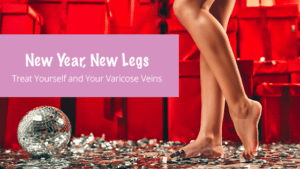 Do you make New Year’s resolutions but find it difficult to follow through? Every year rings in the hope of a “New Year, New Me”! Now’s the time to invest in yourself and get rid of those varicose veins that you keep putting off dealing with. Connect with Summit Skin & Vein Care in the new year and let us educate you on your condition, explain what varicose veins are, what causes them, and the treatments that are available to help you tackle 2023 varicose vein-free.
Do you make New Year’s resolutions but find it difficult to follow through? Every year rings in the hope of a “New Year, New Me”! Now’s the time to invest in yourself and get rid of those varicose veins that you keep putting off dealing with. Connect with Summit Skin & Vein Care in the new year and let us educate you on your condition, explain what varicose veins are, what causes them, and the treatments that are available to help you tackle 2023 varicose vein-free.
What are varicose veins and what causes them to form?
Varicose veins are twisted, enlarged veins that often occur on the legs. They are caused by the backup of blood in the veins, which can occur due to pregnancy, weight gain, or even trauma. Some medical conditions, such as diabetes and collagen disorders, can also increase the risk of developing varicose veins. In most cases, varicose veins are not painful or serious. However, they can sometimes lead to blood clots or ulcers. If you have varicose veins, contact the experts at Summit Skin & Vein Care for treatment options to improve their appearance.
How can you tell if you have varicose veins and what are the symptoms?
Varicose veins are usually easy to spot and feel. They are often large, bulging veins that appear twisted and can be seen just beneath the surface of the skin. They are most commonly found on the legs, but can also occur in other parts of the body. Symptoms of varicose veins may include heavy and achy legs, restless legs, burning and itching, swelling of the legs and feet, cramping of the legs, and discoloration of the skin at the ankle and feet. In more severe cases, varicose veins can lead to open sores or ulcers on the lower legs. If you think you may have varicose veins, reach out to Summit Skin and Vein Care for an appointment and take the first step toward relief from symptoms. If left untreated, varicose veins can become worse over time or in some rare cases, may lead to more serious health complications.
What surgical treatment options are available for varicose veins?
Endovenous ablation is a minimally invasive treatment option for varicose veins that delivers thermal energy to the vein wall, causing it to collapse and close. There are two types of endovenous ablation: Endovenous Laser Ablation (EVLA) and Endovenous Chemical Ablation (EVCA).
Endovenous laser ablation (EVLA) is a type of endovenous ablation that uses lasers to deliver the thermal energy, while endovenous chemical ablation (EVCA) uses chemicals. Endovenous laser ablation (EVLA) is considered the preferred method because it is less painful and has a shorter recovery time than endovenous chemical ablation (EVCA). Endovenous laser ablation (EVLA) is also less likely to cause skin discoloration. However, EVCA is often used on larger veins that are not suitable for EVLA.
The recovery time for both procedures is typically short, with most people able to return to their normal activities within a few days. Endovenous ablation should only be performed by a trained and experienced physician. Summit Skin & Vein Care has years of experience as well as the cutting edge technology for successfully performing both EVLA and EVCA treatments.
Choose Summit Skin & Vein Care to Help You Start 2023 Free of Varicose Veins
Varicose veins are a common problem and can cause pain, swelling, and other symptoms. If you think you might have varicose veins, it’s important to seek medical attention. At Summit Skin & Vein Care our specialists will be happy to discuss the best option for you. Contact us today to set up a free color duplex ultrasound scan!